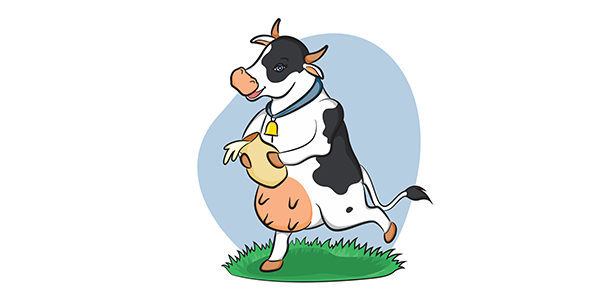See "Peak milk, intake and body weight: How curvy is your cow? Part One" to learn more about your cow's curves. As your dairy herd moves through the lactation, body weight and feed intake curves discussed in Part One, Dr. Mike Hutjens, extension dairy specialist with the University of Illinois, offers these feeding guidelines.
The following are highlights pulled from his full list of feeding recommendations.
Phase 1, far-off dry cows:
- 12 to 13 percent crude protein
- 60 to 80 grams of calcium (lower 15 percent for Jersey cows)
- 30 to 40 grams of phosphorous (lower 15 percent for Jersey cows)
- Limit salt intake to one ounce
- Force feed trace minerals and vitamins
- Provide one-third of the ration dry matter as corn silage
Phase 2, close-up dry cows:
- Increase grain to 5 to 8 pounds of dry matter (DM)
- Increase crude protein to 15 to 16 percent using undegraded intake protein (UIP) sources
- Limit added fat to one-fourth to one-third pound per day
- Maintain 5 to 8 pounds of long forage
- Consider feeding 7 to 10 pounds DM from the high group TMR (contains UIP, fat, grain and higher quality forages) plus the close-up dry cow grain mix and long forage
- Reduce supplemental sodium
- Add anionic salts to prevent low blood calcium
- Add yeast culture (10 to 120 grams per day depend on the product selected)
- Drench with propylene glycol (300 to 500 ml) before calving or feed calcium propionate (one-third pound) if subclinical ketosis is occurring
Phase 3, fresh cows:
- Feed 3 to 5 pounds of high-quality long forage to maintain rumen function
- Consider a fresh cow top dress mixture that contains undegraded protein and digestible fiber (such as soy hulls or citrus pulp) as an energy source
- Increase the ration nutrient concentration to adjust for lower feed intakes
- Supplement yeast culture to stimulate fiber digesting bacteria
- Adding a buffer pack can stabilize rumen pH
- Add propylene glycol (300 to 500 mg) or calcium propionate (one-third pound) to raise blood glucose
Phase 4, early lactation:
- Feed high quality forage to improve dry matter intake (DMI)
- Provide sources of undegraded intake protein to meet lysine and methionine needs
- Increase grain energy gradually (maximum of 1 pound per day)
- Limit the amount of supplemental fat to 1 pound per day
- Allow for adequate feed bunk space
Phase 5, mid lactation:
- Optimize DMI
- Begin replacing lost body condition
- Raise supplemental fat to desired levels
- Review the need for feed additives
Phase 6, late lactation:
- Increase the proportion of forages in the ration
- Supplemental sources of undegraded protein can be reduced
- Remove supplemental fat sources
- Eliminate feed additives
- Replace lost body condition
- Target body condition scores of 3.25 to 3.5 at dry-off time
- Reduce feed costs per cow per day PD






